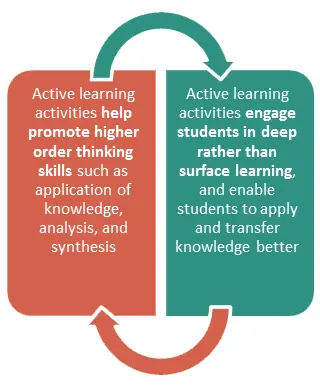Active learning
Active learning methods ask students to engage in their learning by thinking, discussing, investigating, and creating. Active learning involves activities that challenge students’ thinking, promote skills development, foster higher order thinking, and support learning.

What is active learning?
Active learning is an educational approach that immerses students in the discipline through interactive activities such as debates, problem-solving tasks, case analyses, and role-playing exercises. This method shifts more responsibility onto the students compared to traditional lecture-based teaching, yet the role of the teacher and supervisor as a facilitator remains essential in an active learning environment. The duration of active learning exercises can vary, from brief activities to longer sessions spanning multiple classes.
In class, students practice skills, solve problems, struggle with complex questions, make decisions, propose solutions, and explain ideas in their own words through writing and discussion. Timely feedback, from either the instructor or fellow students, is critical to this learning process. Education research shows that incorporating active learning strategies into university courses significantly enhances the student learning experience (Freeman et al., 2014; Theobald et al., 2020).
Active problem-solving confers a deeper understanding of science than does a standard lecture ... We find up to 20% better grades over usual methods… Evidence has been accumulating for decades that students who actively engage with course material will end up retaining it for much longer than they would have otherwise, and they will be better able to apply their knowledge broadly.
How do I incorporate active learning in my teaching?
You may consider some of the following as you design your teaching (Bucklin et al., 2021):
- It is recommended to structure activities around your learning outcomes, particularly for topics that students typically find confusing;
- It is important to clarify the relationship between activities and learning outcomes, as students may not always make this connection independently;
- You may wish to consider reducing lecture content to accommodate discussion and activities. This could involve reviewing your lectures and removing less crucial parts.
- Students may find it beneficial to read before class and participate in low-stakes online quizzes or discussion board posts. This approach can help them arrive at class ready to explore more advanced topics.
- It could be useful to incorporate pauses in your lecture for activities. These activities can be as simple as encouraging students to share their thoughts on a question with a classmate.
- You may wish to provide timely feedback after an activity, and peer feedback could be a viable option, such as through a think-pair-share discussion.
Students who experience active learning in their courses perceive themselves as gaining knowledge and understanding from their courses and view their course work as personally rewarding .

Why use active learning?
Active learning will help you:
Focus on student learning:
- Increased student engagement: Active learning encourages students to take responsibility for their own learning and become more involved in the classroom. Due to the fact that students get to try out the application of the course content, the relevance can be seen quickly and more clearly which is also favourable for motivation.
- Embrace variety in learning by giving your students multiple ways to participate in interactive activities to suit different learning styles.
Connect outcomes, teaching, and assessment:
- Align learning activities and learning outcomes so as to improve outcomes and performance
- Be intentional by making sure that learning activities in your course directly match your intended learning outcomes.
Improve the quality of teaching & learning:
- Studies show that students who actively engage with the course material gain a deeper understanding of science and reduce the risk of failure or dropping out.
- Active learning has been shown to have positive effects in several ways, such as memory, critical thinking, problem solving, motivation and attitude.
- Active learning encourages students to co-operate and work in groups, which contributes to their cultural and linguistic competence development.
- It can also help to reduce student drop-out rates and increase their ability to cooperate.
 Photo: Pixabay
Photo: PixabayShare your experiences and tips
We would like to share examples from different KI contexts of how you apply these concepts. We intend to use your examples to highlight good practice, build a knowledge base and promote collaborative learning.
Contribute with your example!
